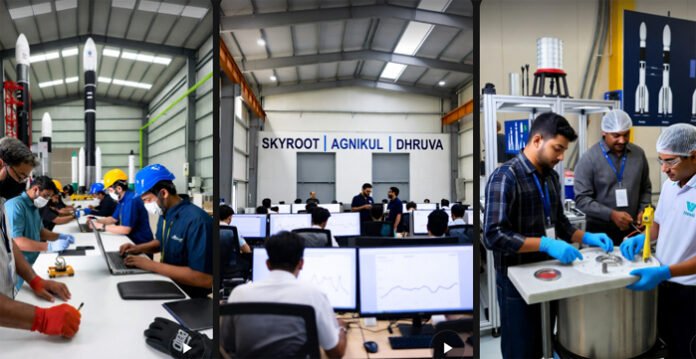🚀 Introduction: India’s Space Sector Enters a New Orbit
India’s space race is no longer just about ISRO. A new generation of private startups — Skyroot Aerospace, Agnikul Cosmos, Bellatrix Aerospace, and Dhruva Space — is reshaping the future of satellite launches, orbital logistics, and commercial payloads.
Since the Indian government opened the space sector to private participation in 2020, innovation has skyrocketed. These startups, led by ex-ISRO engineers and ambitious entrepreneurs, are now positioning India as a global launch hub for small satellites.
“The new ecosystem marks a fundamental shift — India’s private sector is no longer a supplier, but a partner in space,” said an ISRO official familiar with IN-SPACe’s initiatives.
🛰️ Skyroot Aerospace: Leading the Charge
Based in Hyderabad, Skyroot Aerospace is widely viewed as the frontrunner. Founded in 2018 by ex-ISRO scientists Pawan Chandana and Naga Bharath Daka, Skyroot aims to make space “accessible, affordable, and agile.”
Their upcoming Vikram-1 rocket, scheduled for a commercial launch in January 2026, could make Skyroot the first Indian private company to deploy client payloads into orbit.
Highlights:
Payload capacity: ~300 kg to Low-Earth Orbit (LEO)
Cost per launch: $2–3 million
Goal: One rocket launch every three months by 2026, monthly by 2027
Major funding: $95 million raised so far
Skyroot’s integrated production facility in Tirupati — India’s first private rocket manufacturing complex — underscores its long-term industrial ambitions.
🔥 Agnikul Cosmos: Customizable Rockets from Chennai
Hot on Skyroot’s tail is Agnikul Cosmos, incubated at IIT-Madras. Its flagship Agnibaan rocket uses a 3D-printed, semi-cryogenic engine, making it the first of its kind in the world.
The company achieved a successful suborbital test flight in 2024, and plans its first orbital launch by mid-2026.
Key features:
Fully customizable rocket stages for diverse payloads
Launches from Sriharikota’s “Agnibaan Launch Pad” (exclusive private pad)
Cost efficiency via additive manufacturing and in-house engines
“We’re building rockets like startups build software — modular, fast, and adaptive,” says co-founder Srinath Ravichandran.
Agnikul’s flexibility — from engine design to mission configuration — gives it a competitive edge in the bespoke satellite launch market.
🛰️ Dhruva Space: Specializing in Satellite Integration
While Skyroot and Agnikul focus on launch vehicles, Dhruva Space — also based in Hyderabad — dominates the satellite segment.
The firm designs, builds, and integrates small satellites for defense, communication, and academic clients. In 2024, Dhruva successfully deployed multiple nanosats aboard ISRO’s PSLV, validating its commercial model.
Key strengths:
Satellite integration and deployment systems
Partnerships with European and Middle Eastern clients
Focus on modular satellite buses and payload adaptors
Dhruva’s long-term vision: become the “Tata of satellites,” offering end-to-end space hardware solutions.
💡 Bellatrix Aerospace: The Propulsion Innovator
Based in Bengaluru, Bellatrix Aerospace is India’s propulsion powerhouse. Instead of launch vehicles, it focuses on space-grade thrusters and orbital transfer vehicles — crucial for satellite longevity and deep-space maneuvering.
Its flagship product, Orbital Transfer Vehicle (OTV), nicknamed “Pushpak,” is designed to reposition satellites post-launch, reducing space debris and increasing mission efficiency.
Why it matters:
Propulsion tech is a critical part of the global space logistics market
Bellatrix collaborates with ISRO and Indian startups for hybrid projects
Recently raised funding for scaling plasma thruster production
Bellatrix positions itself as the enabler behind India’s broader space ecosystem.
🌏 The Bigger Picture: Why This Race Matters
India’s private space economy, valued at $8 billion in 2024, is projected to cross $40 billion by 2035, according to EY-ISpA.
The country’s key advantages include:
Low launch costs (40–60% cheaper than the U.S.)
Engineering talent pipeline from IITs and ISRO alumni
Government support via IN-SPACe and space FDI reforms
“India could emerge as the world’s second-largest small-satellite launch provider within a decade,” notes Dr. K. Sivan, former ISRO Chairman.
⚖️ Head-to-Head: India’s Private Space Startups
| Company | Founded | Focus | Launch Vehicle | Target Launch | USP |
|---|---|---|---|---|---|
| Skyroot Aerospace | 2018 | Small satellites | Vikram-1 | Jan 2026 | Rapid launch cadence, cost efficiency |
| Agnikul Cosmos | 2017 | Custom rockets | Agnibaan | Mid-2026 | 3D-printed engine tech |
| Dhruva Space | 2012 | Satellites | – | Ongoing | Integration & mission design |
| Bellatrix Aerospace | 2015 | Propulsion | OTV “Pushpak” | 2025–26 | In-orbit mobility solutions |
🧭 Challenges Ahead
Despite enthusiasm, several issues persist:
Regulatory clarity: Licensing and insurance frameworks for private launches still evolving.
Funding gap: Scaling production requires consistent capital flow.
Infrastructure bottlenecks: Limited private launchpads and testing facilities.
Global competition: Players like Rocket Lab, Firefly, and Relativity Space dominate Western markets.
🚀 Conclusion: India’s Orbit-Ready Future
The race among Skyroot, Agnikul, Dhruva, and Bellatrix marks the dawn of a new private space age in India.
Skyroot currently leads the pack with its upcoming commercial launch, but Agnikul’s 3D-printing innovation and Dhruva’s satellite specialization ensure a multi-player ecosystem — not a monopoly.
“The next decade will determine whether India merely participates in space — or truly competes,” says industry analyst Ankit Tiwari.
One thing is certain — the countdown to India’s private orbit revolution has already begun.
















